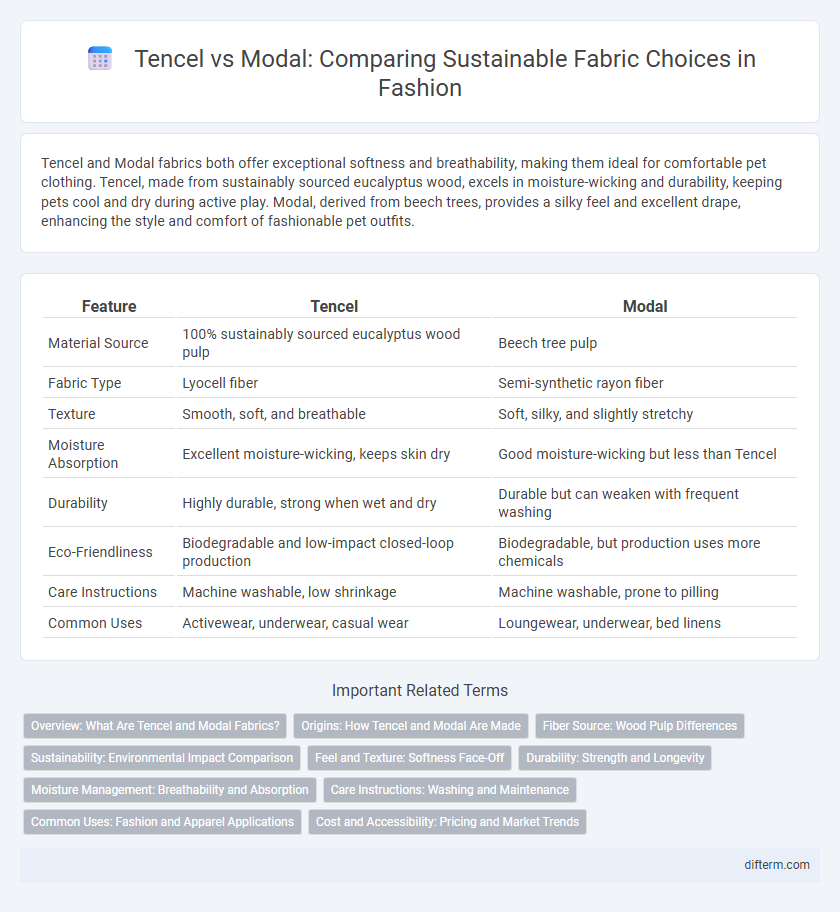Tencel and Modal fabrics both offer exceptional softness and breathability, making them ideal for comfortable pet clothing. Tencel, made from sustainably sourced eucalyptus wood, excels in moisture-wicking and durability, keeping pets cool and dry during active play. Modal, derived from beech trees, provides a silky feel and excellent drape, enhancing the style and comfort of fashionable pet outfits.
Table of Comparison
| Feature | Tencel | Modal |
|---|---|---|
| Material Source | 100% sustainably sourced eucalyptus wood pulp | Beech tree pulp |
| Fabric Type | Lyocell fiber | Semi-synthetic rayon fiber |
| Texture | Smooth, soft, and breathable | Soft, silky, and slightly stretchy |
| Moisture Absorption | Excellent moisture-wicking, keeps skin dry | Good moisture-wicking but less than Tencel |
| Durability | Highly durable, strong when wet and dry | Durable but can weaken with frequent washing |
| Eco-Friendliness | Biodegradable and low-impact closed-loop production | Biodegradable, but production uses more chemicals |
| Care Instructions | Machine washable, low shrinkage | Machine washable, prone to pilling |
| Common Uses | Activewear, underwear, casual wear | Loungewear, underwear, bed linens |
Overview: What Are Tencel and Modal Fabrics?
Tencel and Modal are both semi-synthetic fibers derived from wood pulp, primarily sourced from sustainable eucalyptus trees, offering eco-friendly alternatives in the fashion industry. Tencel, a brand of lyocell, is known for its breathability, moisture-wicking properties, and smooth texture, making it ideal for activewear and sensitive skin. Modal, a type of rayon, provides a silky feel with high durability and excellent color retention, commonly used in underwear, sleepwear, and casual apparel.
Origins: How Tencel and Modal Are Made
Tencel is made from sustainably sourced eucalyptus wood pulp using a closed-loop process that recycles water and solvents, minimizing environmental impact. Modal production involves beech tree pulp and employs a similar closed-loop technology but typically uses more chemical solvents than Tencel. Both fibers are types of rayon, prized for their soft texture and eco-friendly origins compared to traditional synthetic fabrics.
Fiber Source: Wood Pulp Differences
Tencel is derived from sustainably sourced eucalyptus wood pulp using a closed-loop production process that minimizes environmental impact. Modal fabric originates from beech tree pulp, processed with more conventional methods that can involve higher chemical usage. Both fibers belong to the rayon family but differ significantly in their wood pulp sources and environmental footprints.
Sustainability: Environmental Impact Comparison
Tencel fabric, derived from sustainably harvested eucalyptus trees, uses a closed-loop production process that recycles water and solvents, significantly reducing environmental impact compared to Modal, which is made from beech trees but often involves more chemical inputs and less efficient recycling methods. Tencel fibers are biodegradable and require less water and energy during manufacturing, enhancing its eco-friendly profile relative to Modal. Choosing Tencel over Modal supports reduced deforestation, lower carbon emissions, and minimizes pollution in textile production.
Feel and Texture: Softness Face-Off
Tencel fabric boasts a smooth, silky texture that feels cool and breathable against the skin, making it ideal for sensitive skin types. Modal offers a luxuriously soft and supple touch with a slightly warmer and more resilient feel, often described as more plush compared to Tencel. Both fabrics excel in softness, but Tencel's gentle drape contrasts with Modal's stretchier, velvety finish, influencing garment choice based on tactile preference.
Durability: Strength and Longevity
Tencel fabric, derived from eucalyptus fibers, is renowned for its exceptional strength and long-lasting durability, making it highly resistant to wear and tear compared to Modal. Modal, made from beech tree pulp, offers softness and breathability but tends to be less durable under frequent washing or heavy use. Tencel's superior tensile strength and moisture resistance ensure garments retain their shape and integrity over extended periods.
Moisture Management: Breathability and Absorption
Tencel fabric excels in moisture management due to its superior breathability and high absorbency, rapidly wicking sweat away from the skin to keep the wearer cool and dry. Modal also offers effective moisture absorption but is less breathable than Tencel, making it better suited for moderate moisture levels. Both fibers provide comfortable wear, but Tencel's enhanced airflow and quick-drying properties make it ideal for activewear and humid environments.
Care Instructions: Washing and Maintenance
Tencel fabric requires gentle washing in cold water with mild detergent to preserve its softness and prevent shrinkage, often recommended to be air-dried or tumble dried on low heat. Modal benefits from similar care, needing delicate washing cycles and avoidance of harsh chemicals to maintain its smooth texture and vibrant color. Both fabrics perform best when ironed on low settings and stored away from direct sunlight to extend their longevity.
Common Uses: Fashion and Apparel Applications
Tencel fabric, known for its moisture-wicking and breathable properties, is frequently used in activewear, casual clothing, and eco-friendly fashion lines, providing softness and durability. Modal fabric is popular in underwear, loungewear, and lightweight tops due to its silky texture and excellent drape. Both fibers offer sustainable alternatives in the fashion industry, often blended with cotton or synthetic fibers to enhance comfort and performance in apparel.
Cost and Accessibility: Pricing and Market Trends
Tencel fabrics typically command higher prices due to their eco-friendly production process and superior moisture-wicking properties, making them less accessible in budget-conscious markets. Modal, derived from beech tree pulp, offers a more affordable alternative with a softer hand feel, leading to broader availability in mass-market fashion segments. Market trends indicate growing consumer preference for sustainable textiles, gradually enhancing Tencel's accessibility despite its premium cost.
Tencel vs Modal (fabric types) Infographic

 difterm.com
difterm.com